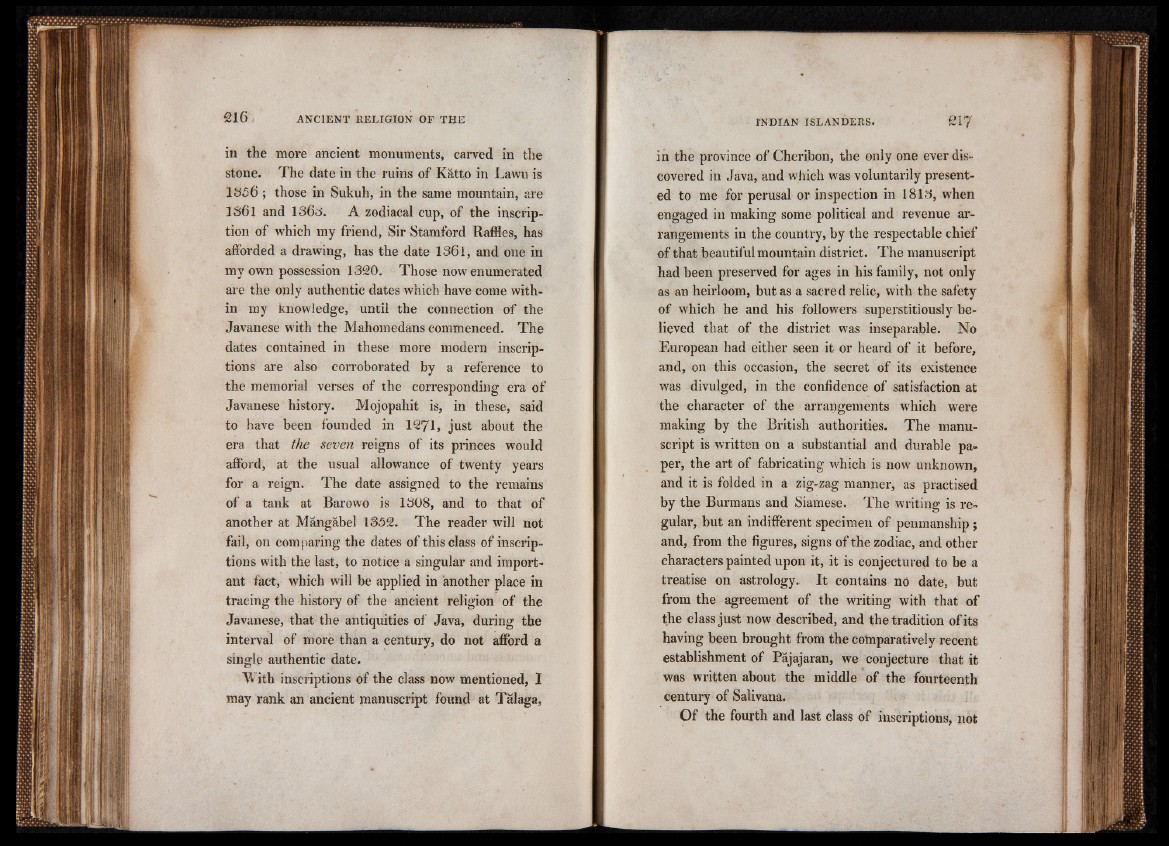
in the more ancient monuments, carved in the
stone. The date in the ruins of Katto in Lawu is
1556 ; those in Sukuh, in the same mountain, are
3S6l and 1363. A zodiacal cup, of the inscription
of which my friend, Sir Stamford Raffles, has
afforded a drawing, has the date 136l, and one in
my own possession 1320. Those now enumerated
are the only authentic dates which have come within
my knowledge, until the connection of the
Javanese with the Mahomedans commenced. The
dates contained in these more modern inscriptions
are also corroborated by a reference to
the memorial verses of the corresponding era of
Javanese history. Mojopahit is, in these, said
to have been founded in 1 2 7 1 , just about the
era that the seven reigns of its princes would
afford, at the usual allowance of twenty years
for a reign. The date assigned to the remains
of a tank at Barowo is 1308, and to that of
another at Mangabel 1352. The reader will not
fail, on comparing the dates of this class of inscriptions
with the last, to notice a singular and important
fact, which will be applied in another place in
tracing the history of the ancient religion of the
Javanese, that the antiquities of Java, during the
interval of more than a century, do not afford a
single authentic date.
With inscriptions of the class now mentioned, I
may rank an ancient manuscript found at Talaga,
in the province of Cheribon, the only one ever discovered
in Java, and which was voluntarily presented
to me for perusal or inspection in 1813, when
engaged in making some political and revenue arrangements
in the country, by the respectable chief
of that beautiful mountain district. The manuscript
had been preserved for ages in his family, not only
as an heirloom, but as a sacred relic, with the safety
of which he and his followers superstitiously believed
that of the district was inseparable. No
European had either seen it or heard of it before,
and, on this occasion, the secret of its existence
was divulged, in the confidence of satisfaction at
the character of the arrangements which were
making by the British authorities. The manuscript
is written on a substantial and durable paper,
the art of fabricating which is now unknown,
and it is folded in a zig-zag manner, as practised
by the Burmans and Siamese. The writing is regular,
but an indifferent specimen of penmanship;
and, from the figures, signs of the zodiac, and other
characters painted upon it, it is conjectured to be a
treatise on astrology. It contains no date, but
from the agreement of the writing with that of
the class just now described, and the tradition of its
having been brought from the comparatively recent
establishment of Pajajaran, we conjecture that it
was written about the middle of the fourteenth
century of Salivana.
Of the fourth and last class of inscriptions, not